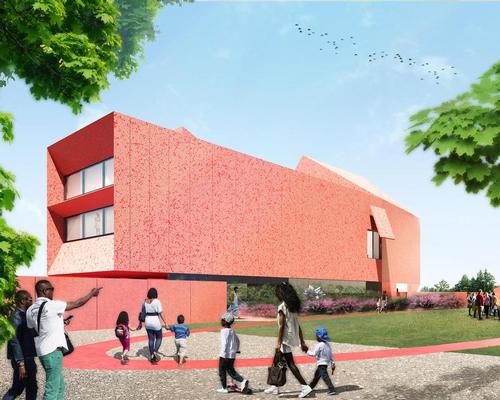19 Jun 2017
Work begins on Sir David Adjaye's crimson art museum for late artist's 'dream city'
BY Kim Megson

Ground has broken on a new contemporary art museum in San Antonio, Texas, with a design by British architect Sir David Adjaye that was inspired by an artist’s dream.
The modern crimson-hued building, called Ruby City, will house the Linda Pace Foundation’s growing collection of more than 800 paintings, sculptures, installations and video works by contemporary artists from around the world. Pace, who died in 2007, was an artist and philanthropist who believed in the power of creativity as a social force. She started the foundation to “foster the creation, presentation and understanding of innovative expression” through art.
The 14,000sq ft (1,300sq m), two-story building will cost US$16m (€14.3m, £12.5m) and has been privately funded by the foundation. It will face the San Pedro Creek Improvements Project; a natural creek habitat and linear park being constructed by the city to replace a concrete-lined waterway/
Describing how the museum’s vivid design was developed, foundation trustee Kathryn Kanjo said: “As a Jungian, Linda cultivated the power and symbolism of dreams. A sparkling crimson building appeared to her in her sleep. Using coloured-pencil, she sketched the fanciful image and shared it with David Adjaye.
“With his bold sense of volume and materials, David has interpreted Linda's dream city into a faceted, beckoning form, a Ruby City.”
The exterior of the structure will be clad in deep red panels of shimmering precast concrete with glass and mica aggregate. A dramatic rooftop of sloping angles and skylights will rise to varying heights and echo cut-away spaces at the building’s base.
An ruby-patterned entrance plaza will be formed by the building’s cantilevered structure and the ground floor lobby – merging the indoor and outdoor elements. A grand staircase will lead to a series of gallery spaces, which in contrast to the red exteriors will feature concrete floors with white walls and ceilings.
“We have sought to engage with the wider project,” said Adjaye, “to rehabilitate the area into a vibrant new urban park and cultural campus. So the design for the building is about creating an important civic movement for the city – and the plaza will be a critical feature of this narrative.”
The wider campus, also known as Ruby City, will extend from South Flores Street to the San Pedro Creek. Other spaces there will include a new sculpture garden; an existing one-acre public green space named CHRISpark in memory of Pace’s son; and SPACE, a foundation gallery that opened to the public in 2014.
Ruby City is slated for completion in late 2018 to coincide with the celebrations marking San Antonio’s 300th birthday.
Adjaye’s practice Adjaye Associates are collaborating on the project with local firm Alamo Architects and contractor Whiting-Turner.
Adjaye is known for weaving local geographies and cultural legacies together in his designs, particularly for cultural buildings such as the National Museum of African American History and Culture in Washington D.C and the Aishti Foundation art museum in Beirut.
A travelling exhibition exploring his philosophy and work to date has recently opened at the Garage Museum of Contemporary Art in Moscow. Called David Adjaye: Form, Heft, Material, it will run until 30 July.
2017 has been a successful year so far for Adjaye, who has received a knighthood and been named the world’s most influential architect by Time magazine.
Close Window